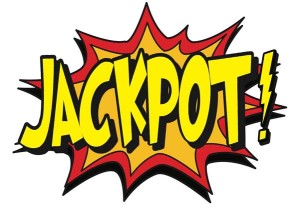 Odds are, you weren’t one of the three winners of the $1.6 billion Powerball jackpot…
Odds are, you weren’t one of the three winners of the $1.6 billion Powerball jackpot…
And frankly, that’s okay. Most of the entertainment in playing (and you really shouldn’t be playing for more than entertainment) is in the anticipation… The not knowing… The waiting and hoping that you will be the winner.
(Even if you did win, odds are you’ll be totally miserable and totally bankrupt in 5 years anyway, with a lot less friends than you have today.)
And if you threw a few bucks at it, for entertainment, that’s just fine.
But now that you’ve realized you didn’t in fact win a third of the $1.6 billion jackpot, whaddya do?
It’s time to go about building wealth another way…
I’ve been following a web traffic guy named Justin Brooke, who has bought traffic (that is, online ads) for some pretty huge marketers.
And he recently wrote an article titled What I Learned From A Million Dollar Per Month Campaign.
He was just one media buyer on the team, but he got an inside view.
This was a client using two separate offers to generate over $1 million per month in sales. Driving traffic from multiple sources, into these two funnels, and making into the 7-figures in revenue every month.
The biggest lesson from a $1-million-per-month operation?
Well, I encourage you to read Justin’s article in full, because it’s definitely enlightening. But I’ll share the biggest lesson, with a little reflection.
“Profit is grown, not made.”
Even the best marketers don’t go from zero to $1 mil every month in sales in a single leap.
Didn’t you read Claude Hopkins? Test small, confirm results, then scale up.
$1 mil per month starts with $100 per month. Or $1,000. Then when that works, rolling the money back into the campaign, looking for more traffic. Testing, tweaking, refining as you go.
Make it profitable, or at least get it operating at an acceptable loss (if you’ve got the cash to do so).
Then as you grow, refine the elements of your process to make them work better, more profitably. Test every step of your funnel to optimize conversions. Find the great traffic, the good traffic, the mediocre traffic, and the bad traffic. Cut the bad, and figure out what to do with the rest.
You want $1 million per month — it starts with knowing your numbers…
If you were to reach your total target market, how many people would that be? How many people do you have direct access to through your current channels?
How much does it cost to acquire a customer? Take the total cost of advertising, divide it by the total number of sales, and you have a dollar value it takes to bring in one customer. But this can be nuanced, and ideally tracked on a per-source, per-channel, even per-ad and per-keyword level (or whatever way you can break down your audience). What you need to understand is how much it costs to bring in a new customer from each traffic source.
What’s the average order value? That is, what is the value of every customer who comes in through the front door? And if you have a deep funnel, factor that in.
Maybe your first product is $5, your second $50, and your third $500. If 20% of the people who buy the first product buy the second, and 20% of those buy the third, your average order value is $35 (let’s assume a digital product so we don’t have to factor in fulfillment/margin). That is, for every $5 you bring in, you’re actually — statistically speaking — bringing in $35. So, if you’re able to acquire new customers for your $5 product for less than $35, you’re making a profit.
(Also note: with multiple traffic sources this can be very different. One source may have an average value of $8 while another has $80 — knowing this can drastically change your strategy for spending traffic on these sources.)
Also, what’s your daily order volume? If you’re serious about buying traffic and want to scale fast, you have to be aware of this figure. And if you’re going temporarily negative to acquire new customers, you can only scale on a level that you can afford in terms of daily volume.
There are other numbers, too. Conversion rate, click-through, time on page (or time viewing for video), and more. In context, these can be valuable numbers. But each represents an inconsequential step of the process relative to the numbers above. An ad with a higher click-through may sill give you a higher cost to acquire a customer or lower average order value. It’s always worth testing and optimizing on these numbers, but only as long as they push the more critical metrics above in the right direction.
Bigger picture thoughts…
All of this speaks to taking lots of small steps in the right direction, rather than trying to “win the Powerball” of marketing.
Yes, we all like to dream of hitting that jackpot — and what we’ll do if we get the money.
But the more realistic way to build wealth — whether we’re talking about investing or business — is consistent improvement through time, with a focus on compounding the results.
Taking a ton of little steps in the right direction, focusing always on forward progress, is a much more reliable way to getting the big payoff than gambling on a big win.
More and more I’m recognizing — and hoping you will, too — that success comes as a result of a lot of little decisions and actions in the right direction than it does from big leaps.
Yours for bigger breakthroughs,
Roy



